| Revision as of 04:04, 14 July 2024 editCodeTalker (talk | contribs)Extended confirmed users, Rollbackers35,196 edits Reverted 1 edit by 45.117.215.33 (talk) to last revision by OhnoitsjamieTags: Twinkle Undo Reverted← Previous edit | Latest revision as of 20:35, 14 January 2025 edit undoDiscospinster (talk | contribs)Administrators466,213 editsm Reverted edits by 174.77.123.150 (talk) (HG) (3.4.12)Tags: Huggle Rollback Disambiguation links added | ||
| (24 intermediate revisions by 13 users not shown) | |||
| Line 1: | Line 1: | ||
| {{short description|Tethered aircraft}} | {{short description|Tethered aircraft}} | ||
| {{Other uses}} | {{Other uses}} | ||
| ] - Solidarity Kites Fundraising event in ] (2024)]] | |||
| ] Giant Kite Festival is held every July in ], Japan.<ref>](video)</ref>]] ] | ] Giant Kite Festival is held every July in ], Japan.<ref>](video)</ref>]] ] | ||
| ]. This sparless, ram-air inflated kite, has a complex bridle formed of many strings attached to the face of the wing.]] | ]. This sparless, ram-air inflated kite, has a complex bridle formed of many strings attached to the face of the wing.]] | ||
| Line 6: | Line 7: | ||
| A '''kite''' is a ]ed ] or lighter-than-air craft with ] surfaces that react against the air to create ] and ] forces.<ref>]</ref> A kite consists of wings, tethers and anchors. Kites often have a bridle and tail to guide the face of the kite so the wind can lift it.<ref>{{Cite book|title = The Magnificent Book of Kites: Explorations in Design, Construction, Enjoyment & Flight|last = Eden|first = Maxwell|publisher = Sterling Publishing Company, Inc.|year = 2002|isbn = 9781402700941|location = New York|pages = 18}}</ref> Some kite designs do not need a bridle; ]s can have a single attachment point. A kite may have fixed or moving anchors that can balance the kite. The name is derived from the ], the hovering bird of prey.<ref>{{Cite web|url=https://www.etymonline.com/word/kite|title=kite | Etymology, origin and meaning of kite by etymonline|website=Etymonline.com|access-date=14 December 2021}}</ref> | A '''kite''' is a ]ed ] or lighter-than-air craft with ] surfaces that react against the air to create ] and ] forces.<ref>]</ref> A kite consists of wings, tethers and anchors. Kites often have a bridle and tail to guide the face of the kite so the wind can lift it.<ref>{{Cite book|title = The Magnificent Book of Kites: Explorations in Design, Construction, Enjoyment & Flight|last = Eden|first = Maxwell|publisher = Sterling Publishing Company, Inc.|year = 2002|isbn = 9781402700941|location = New York|pages = 18}}</ref> Some kite designs do not need a bridle; ]s can have a single attachment point. A kite may have fixed or moving anchors that can balance the kite. The name is derived from the ], the hovering bird of prey.<ref>{{Cite web|url=https://www.etymonline.com/word/kite|title=kite | Etymology, origin and meaning of kite by etymonline|website=Etymonline.com|access-date=14 December 2021}}</ref> | ||
| There are several shapes of |
There are several shapes of kites. | ||
| The ] that sustains the kite in flight is generated when air moves around the kite's surface, producing low pressure above and high pressure below the wings.<ref>{{cite web |url=http://www.grc.nasa.gov/WWW/K-12/airplane/guided.htm |title=Beginner's Guide to Aeronautics |publisher=NASA |access-date=2012-10-03 |archive-url=https://web.archive.org/web/20150325054529/http://www.grc.nasa.gov/WWW/K-12/airplane/guided.htm |archive-date=2015-03-25 |url-status=dead }}</ref> The interaction with the wind also generates horizontal ] along the direction of the wind. The resultant force vector from the lift and drag force components is opposed by the tension of one or more of the ] or ]s to which the kite is attached.<ref>{{Cite web|url=http://www.kitelife.com/magazine/issue39/altitude39/content.php|archiveurl=https://web.archive.org/web/20081201125120/http://www.kitelife.com/magazine/issue39/altitude39/content.php|url-status=dead|title=Flying High, Down Under|archive-date=1 December 2008|access-date=14 December 2021}}</ref> The anchor point of the kite line may be static or moving (e.g., the towing of a kite by a running person, boat, free-falling anchors as in paragliders and fugitive parakites<ref>{{cite book|author=Woglom, Gilbert Totten |title=Parakites: A treatise on the making and flying of tailless kites for scientific purposes and for recreation |publisher=Putnam|year=1896 |oclc=2273288 |ol=6980132M }}</ref><ref>{{Cite web|url=http://cires.colorado.edu/science/field/kites/|archiveurl=https://web.archive.org/web/20080314091057/http://cires.colorado.edu/science/field/kites/|url-status=dead|title=''Science in the Field'': Ben Balsley, CIRES Scientist in the Field Gathering atmospheric dynamics data using kites. Kites are anchored to boats on the Amazon River employed to sample levels of certain gases in the air.|archive-date=14 March 2008|access-date=14 December 2021}}</ref> or vehicle).<ref>{{cite web|url=http://uboat.net/technical/bachstelze.htm |title=The Bachstelze Article describes the Fa-330 Rotary Wing Kite towed by its mooring to the submarine. The kite was a man-lifter modeled after the autogyro principle |website=Uboat.net |access-date=2012-10-03}}</ref><ref>{{Cite web|url=http://www.drachen.org/journals/journal22/Journal-22/TalStreet.pdf|archiveurl=https://web.archive.org/web/20110723191633/http://www.drachen.org/journals/journal22/Journal-22/TalStreet.pdf|url-status=dead|title=Kite Fashions: Above, Below, Sideways. Expert kite fliers sometimes tie a flying kite to a tree to have the kite fly for days on end.|archive-date=23 July 2011|access-date=14 December 2021}}</ref> | The ] that sustains the kite in flight is generated when air moves around the kite's surface, producing low pressure above and high pressure below the wings.<ref>{{cite web |url=http://www.grc.nasa.gov/WWW/K-12/airplane/guided.htm |title=Beginner's Guide to Aeronautics |publisher=NASA |access-date=2012-10-03 |archive-url=https://web.archive.org/web/20150325054529/http://www.grc.nasa.gov/WWW/K-12/airplane/guided.htm |archive-date=2015-03-25 |url-status=dead }}</ref> The interaction with the wind also generates horizontal ] along the direction of the wind. The resultant force vector from the lift and drag force components is opposed by the tension of one or more of the ] or ]s to which the kite is attached.<ref>{{Cite web|url=http://www.kitelife.com/magazine/issue39/altitude39/content.php|archiveurl=https://web.archive.org/web/20081201125120/http://www.kitelife.com/magazine/issue39/altitude39/content.php|url-status=dead|title=Flying High, Down Under|archive-date=1 December 2008|access-date=14 December 2021}}</ref> The anchor point of the kite line may be static or moving (e.g., the towing of a kite by a running person, boat, free-falling anchors as in paragliders and fugitive parakites<ref>{{cite book|author=Woglom, Gilbert Totten |title=Parakites: A treatise on the making and flying of tailless kites for scientific purposes and for recreation |publisher=Putnam|year=1896 |oclc=2273288 |ol=6980132M }}</ref><ref>{{Cite web|url=http://cires.colorado.edu/science/field/kites/|archiveurl=https://web.archive.org/web/20080314091057/http://cires.colorado.edu/science/field/kites/|url-status=dead|title=''Science in the Field'': Ben Balsley, CIRES Scientist in the Field Gathering atmospheric dynamics data using kites. Kites are anchored to boats on the Amazon River employed to sample levels of certain gases in the air.|archive-date=14 March 2008|access-date=14 December 2021}}</ref> or vehicle).<ref>{{cite web|url=http://uboat.net/technical/bachstelze.htm |title=The Bachstelze Article describes the Fa-330 Rotary Wing Kite towed by its mooring to the submarine. The kite was a man-lifter modeled after the autogyro principle |website=Uboat.net |access-date=2012-10-03}}</ref><ref>{{Cite web|url=http://www.drachen.org/journals/journal22/Journal-22/TalStreet.pdf|archiveurl=https://web.archive.org/web/20110723191633/http://www.drachen.org/journals/journal22/Journal-22/TalStreet.pdf|url-status=dead|title=Kite Fashions: Above, Below, Sideways. Expert kite fliers sometimes tie a flying kite to a tree to have the kite fly for days on end.|archive-date=23 July 2011|access-date=14 December 2021}}</ref> | ||
| Line 19: | Line 20: | ||
| ]'' in which the kite is titled ''How to make fire Drakes'']] | ]'' in which the kite is titled ''How to make fire Drakes'']] | ||
| Kites were invented in ], though their exact origin can only be speculated. The oldest depiction of a kite is from a ] period cave painting in ], southeast ], ], which has been dated from 9500–9000 years B.C.<ref>{{citation|url= https://www.thejakartapost.com/news/2015/12/08/a-tale-prehistoric-horses-south-sulawesi.html|title= A tale of prehistoric horses in South Sulawesi|work=Jakartapost|language=en}}</ref> It depicts a type of kite called ''kaghati'', which are still used by modern Muna people.<ref>{{Cite web|url=http://wolfgangbieck.gmxhome.de/Der-erste-Drachenflieger.html|title="The First Kiteman" -Proof by a prehistoric cave-painting in Indonesia|last=Bieck|first=Wolfgang|date=July 2002|access-date=24 July 2019|archive-date=8 September 2017|archive-url=https://web.archive.org/web/20170908195650/http://wolfgangbieck.gmxhome.de/Der-erste-Drachenflieger.html|url-status=dead}}</ref> The kite is made from ''kolope'' (forest tuber) leaf for the mainsail, bamboo skin as the frame, and twisted forest pineapple fiber as rope, though modern kites use string.<ref>{{citation|url= https://www.tempo.co/hiburan/layang-layang-tertua-di-dunia-berasal-dari-indonesia-sudah-ada-sejak-4-ribu-tahn-lalu-149308|title= Layang-layang Tertua di Dunia Berasal dari Indonesia, Sudah Ada Sejak 4 Ribu Tahn Lalu|work=Tempo|language=id}}</ref><ref>{{Cite news|url=https://seasia.co/2018/06/02/the-top-10-must-know-facts-about-the-world-s-first-oldest-kite|title=The Top 10 Must-Know Facts About The World's First & Oldest Kite|last=Salikha|first=Adelaida|date=2 June 2018|work=Seasia|access-date=24 July 2019}}</ref> | |||
| ⚫ | |||
| ⚫ | In China, the kite has been claimed as the invention of the 5th-century BC Chinese philosophers ] (also Mo Di, or Mo Ti) and ] (also Gongshu Ban, or Kungshu Phan). Materials ideal for kite building were readily available including ] fabric for sail material; fine, high-tensile-strength silk for flying line; and resilient ] for a strong, lightweight framework. By 549 AD, ] kites were certainly being flown, as it was recorded that in that year a paper kite was used as a message for a rescue mission. Ancient and medieval Chinese sources describe kites being used for measuring distances, testing the wind, lifting men, signaling, and communication for military operations. The earliest known Chinese kites were flat (not bowed) and often rectangular. Later, tailless kites incorporated a stabilizing bowline. Kites were decorated with mythological motifs and legendary figures; some were fitted with strings and whistles to make musical sounds while flying.<ref>] (1965), ''Science and Civilisation in China'', p. 576–580</ref><ref>{{cite book|last1=Sarak|first1=Sim|last2=Yarin|first2=Cheang|title=Khmer Kites|year=2002|publisher=Ministry of Culture and Fine Arts|location=Cambodia|asin=B005VDYAAW}}</ref><ref>, 1907, The New York Times.</ref> | ||
| ], 1766 (])]] | ], 1766 (])]] | ||
| Line 99: | Line 102: | ||
| * Kites may be maneuvered dynamically which increases the force available dramatically | * Kites may be maneuvered dynamically which increases the force available dramatically | ||
| * There is no need for mechanical structures to withstand bending forces; vehicles or hulls can be very light or dispensed with all together | * There is no need for mechanical structures to withstand bending forces; vehicles or hulls can be very light or dispensed with all together | ||
| ===Electricity generation=== | |||
| Computer-controlled kites can serve as a method of ] when windmills are impractical. Several companies have introduced self-contained crates and shipping containers that provide an alternative to gas-powered generators for remote locations. Such systems use a combination of autonomous, self-launching kites for generation and batteries to store excess power for when winds are low or when otherwise draw exceeds supply. Some designs are tethered to long lines to reach high altitude winds which are always present, even when ground level winds are unavailable or insufficient.<ref>{{cite magazine |url=https://www.smithsonianmag.com/innovation/could-high-flying-kites-power-your-home-180979894/ |title=Could High-Flying Kites Power Your Home? |magazine=] |publisher=] |date=April 12, 2022 |access-date=2024-11-11}}</ref><ref>{{cite news |url=https://www.theguardian.com/environment/2008/aug/03/renewableenergy.energy |title=Giant kites to tap power of the high wind |first=Alok |last=Jha |work=The Observer |date=2008-08-03 |access-date=2024-11-11}}</ref><ref>{{cite web |url=https://thekitepower.com/ |title=Kitepower Airborne Wind Energy |access-date=2024-11-11}}</ref><ref>{{cite web |url=https://skysails-power.com/ |title=Wind Power: Unleashing its Full Potential |access-date=2024-11-11}}</ref><ref>{{cite web |url=https://www.kitemill.com/ |title=The future of green energy is found high up in the skies |access-date=2024-11-11}}</ref> | |||
| ===Underwater kites=== | ===Underwater kites=== | ||
| Line 207: | Line 213: | ||
| ==Types== | ==Types== | ||
| {{Main|Kite types}} | |||
| * ] | * ] | ||
| * ] | * ] | ||
| Line 258: | Line 263: | ||
| ] | ] | ||
| ] | |||
| ] | ] | ||
| ] | ] | ||
Latest revision as of 20:35, 14 January 2025
Tethered aircraft For other uses, see Kite (disambiguation).



A kite is a tethered heavier-than-air or lighter-than-air craft with wing surfaces that react against the air to create lift and drag forces. A kite consists of wings, tethers and anchors. Kites often have a bridle and tail to guide the face of the kite so the wind can lift it. Some kite designs do not need a bridle; box kites can have a single attachment point. A kite may have fixed or moving anchors that can balance the kite. The name is derived from the kite, the hovering bird of prey.
There are several shapes of kites.
The lift that sustains the kite in flight is generated when air moves around the kite's surface, producing low pressure above and high pressure below the wings. The interaction with the wind also generates horizontal drag along the direction of the wind. The resultant force vector from the lift and drag force components is opposed by the tension of one or more of the lines or tethers to which the kite is attached. The anchor point of the kite line may be static or moving (e.g., the towing of a kite by a running person, boat, free-falling anchors as in paragliders and fugitive parakites or vehicle).
The same principles of fluid flow apply in liquids, so kites can be used in underwater currents. Paravanes and otter boards operate underwater on an analogous principle.
Man-lifting kites were made for reconnaissance, entertainment and during development of the first practical aircraft, the biplane.
Kites have a long and varied history and many different types are flown individually and at festivals worldwide. Kites may be flown for recreation, art or other practical uses. Sport kites can be flown in aerial ballet, sometimes as part of a competition. Power kites are multi-line steerable kites designed to generate large forces which can be used to power activities such as kite surfing, kite landboarding, kite buggying and snow kiting.
History
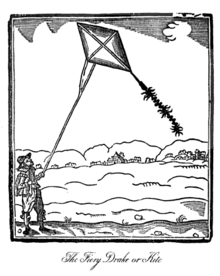
Kites were invented in Asia, though their exact origin can only be speculated. The oldest depiction of a kite is from a mesolithic period cave painting in Muna island, southeast Sulawesi, Indonesia, which has been dated from 9500–9000 years B.C. It depicts a type of kite called kaghati, which are still used by modern Muna people. The kite is made from kolope (forest tuber) leaf for the mainsail, bamboo skin as the frame, and twisted forest pineapple fiber as rope, though modern kites use string.
In China, the kite has been claimed as the invention of the 5th-century BC Chinese philosophers Mozi (also Mo Di, or Mo Ti) and Lu Ban (also Gongshu Ban, or Kungshu Phan). Materials ideal for kite building were readily available including silk fabric for sail material; fine, high-tensile-strength silk for flying line; and resilient bamboo for a strong, lightweight framework. By 549 AD, paper kites were certainly being flown, as it was recorded that in that year a paper kite was used as a message for a rescue mission. Ancient and medieval Chinese sources describe kites being used for measuring distances, testing the wind, lifting men, signaling, and communication for military operations. The earliest known Chinese kites were flat (not bowed) and often rectangular. Later, tailless kites incorporated a stabilizing bowline. Kites were decorated with mythological motifs and legendary figures; some were fitted with strings and whistles to make musical sounds while flying.

After its introduction into India, the kite further evolved into the fighter kite, known as the patang in India, where thousands are flown every year on festivals such as Makar Sankranti.
Kites were known throughout Polynesia, as far as New Zealand, with the assumption being that the knowledge diffused from China along with the people. Anthropomorphic kites made from cloth and wood were used in religious ceremonies to send prayers to the gods. Polynesian kite traditions are used by anthropologists to get an idea of early "primitive" Asian traditions that are believed to have at one time existed in Asia.
Kites were late to arrive in Europe, although windsock-like banners were known and used by the Romans. Stories of kites were first brought to Europe by Marco Polo towards the end of the 13th century, and kites were brought back by sailors from Japan and Malaysia in the 16th and 17th centuries. Konrad Kyeser described dragon kites in Bellifortis about 1400 AD. Although kites were initially regarded as mere curiosities, by the 18th and 19th centuries they were being used as vehicles for scientific research.

In 1752, Benjamin Franklin published an account of a kite experiment to prove that lightning was caused by electricity.
Kites were also instrumental in the research of the Wright brothers, and others, as they developed the first airplane in the late 1800s. Several different designs of man-lifting kites were developed. The period from 1860 to about 1910 became the European "golden age of kiting".
In the 20th century, many new kite designs are developed. These included Eddy's tailless diamond, the tetrahedral kite, the Rogallo wing, the sled kite, the parafoil, and power kites. Kites were used for scientific purposes, especially in meteorology, aeronautics, wireless communications and photography. The Rogallo wing was adapted for stunt kites and hang gliding and the parafoil was adapted for parachuting and paragliding.
The rapid development of mechanically powered aircraft diminished interest in kites. World War II saw a limited use of kites for military purposes (survival radio, Focke Achgelis Fa 330, military radio antenna kites).
Kites are now mostly used for recreation. Lightweight synthetic materials (ripstop nylon, plastic film, carbon fiber tube and rod) are used for kite making. Synthetic rope and cord (nylon, polyethylene, kevlar and dyneema) are used as bridle and kite line.
Materials

Designs often emulate flying insects, birds, and other beasts, both real and mythical. The finest Chinese kites are made from split bamboo (usually golden bamboo), covered with silk, and hand painted. On larger kites, clever hinges and latches allow the kite to be disassembled and compactly folded for storage or transport. Cheaper mass-produced kites are often made from printed polyester rather than silk.
Tails are used for some single-line kite designs to keep the kite's nose pointing into the wind. Spinners and spinsocks can be attached to the flying line for visual effect. There are rotating wind socks which spin like a turbine. On large display kites these tails, spinners and spinsocks can be 50 feet (15 m) long or more.
Modern aerobatic kites use two or four lines to allow fine control of the kite's angle to the wind. Traction kites may have an additional line to de-power the kite and quick-release mechanisms to disengage flyer and kite in an emergency.
Practical uses
Main article: Kite applicationsKites have been used for human flight, military applications, science and meteorology, photography, lifting radio antennas, generating power, aerodynamics experiments, and much more.
Military applications
Kites have been used for military purposes in the past, such as signaling, delivery of ammunition, and for observation, both by lifting an observer above the field of battle and by using kite aerial photography.
Kites were first used in warfare by the Chinese. During the Song dynasty the Fire Crow, a kite carrying incendiary powder, a fuse, and a burning stick of incense was developed as a weapon.
According to Samguk Sagi, in 647 Kim Yu-sin, a Korean general of Silla rallied his troops to defeat rebels by using flaming kites which also frightened the enemy.
Russian chronicles mention Prince Oleg of Novgorod use of kites during the siege of Constantinople in 906: "and he crafted horses and men of paper, armed and gilded, and lifted them into the air over the city; the Greeks saw them and feared them".
Walter de Milemete's 1326 De nobilitatibus, sapientiis, et prudentiis regum treatise depicts a group of knights flying kite laden with a black-powder filled firebomb over the wall of city.
Kites were also used by Admiral Yi of the Joseon Dynasty (1392–1910) of Korea. During the Japanese invasions of Korea (1592–1598), Admiral Yi commanded his navy using kites. His kites had specific markings directing his fleet to perform various orders.

In the modern era the British Army used kites to haul human lookouts into the air for observation purposes, using the kites developed by Samuel Franklin Cody. Barrage kites were used to protect shipping during the Second World War. Kites were also used for anti-aircraft target practice. Kites and kytoons were used for lofting communications antenna. Submarines lofted observers in rotary kites.
Palestinians from the Gaza Strip have flown firebomb kites over the Israel–Gaza barrier, setting fires on the Israeli side of the border, hundreds of dunams of Israeli crop fields were burned by firebomb kites launched from Gaza, with an estimated economic loss of several millions of shekels.
Science and meteorology
Kites have been used for scientific purposes, such as Benjamin Franklin's famous experiment proving that lightning is electricity. Kites were the precursors to the traditional aircraft, and were instrumental in the development of early flying craft. Alexander Graham Bell experimented with very large man-lifting kites, as did the Wright brothers and Lawrence Hargrave. Kites had a historical role in lifting scientific instruments to measure atmospheric conditions for weather forecasting. Francis Ronalds and William Radcliffe Birt described a very stable kite at Kew Observatory as early as 1847 that was trialled for the purpose of supporting self-registering meteorological instruments at height.
Radio aerials and light beacons
Kites can be used for radio purposes, by kites carrying antennas for MF, LF or VLF-transmitters. This method was used for the reception station of the first transatlantic transmission by Marconi. Captive balloons may be more convenient for such experiments, because kite-carried antennas require a lot of wind, which may be not always possible with heavy equipment and a ground conductor. It must be taken into account during experiments, that a conductor carried by a kite can lead to high voltage toward ground, which can endanger people and equipment, if suitable precautions (grounding through resistors or a parallel resonant circuit tuned to transmission frequency) are not taken.
Kites can be used to carry light effects such as lightsticks or battery powered lights.
Kite traction
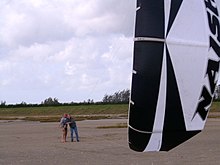
Kites can be used to pull people and vehicles downwind. Efficient foil-type kites such as power kites can also be used to sail upwind under the same principles as used by other sailing craft, provided that lateral forces on the ground or in the water are redirected as with the keels, center boards, wheels and ice blades of traditional sailing craft. In the last two decades several kite sailing sports have become popular, such as kite buggying, kite land boarding, kite boating and kite surfing. Snow kiting has also become popular in recent years.
Kite sailing opens several possibilities not available in traditional sailing:
- Wind speeds are greater at higher altitudes
- Kites may be maneuvered dynamically which increases the force available dramatically
- There is no need for mechanical structures to withstand bending forces; vehicles or hulls can be very light or dispensed with all together
Electricity generation
Computer-controlled kites can serve as a method of electricity generation when windmills are impractical. Several companies have introduced self-contained crates and shipping containers that provide an alternative to gas-powered generators for remote locations. Such systems use a combination of autonomous, self-launching kites for generation and batteries to store excess power for when winds are low or when otherwise draw exceeds supply. Some designs are tethered to long lines to reach high altitude winds which are always present, even when ground level winds are unavailable or insufficient.
Underwater kites
Underwater kites are now being developed to harvest renewable power from the flow of water.
- A kite was used in minesweeping operations from the First World War: this was a foil "attached to a sweep-wire submerging it to the requisite depth when it is towed over a minefield" (OED, 2021). See also paravane.
Cultural uses
Kite festivals are a popular form of entertainment throughout the world. They include large local events, traditional festivals which have been held for hundreds of years and major international festivals which bring in kite flyers from other countries to display their unique art kites and demonstrate the latest technical kites.
Many countries have kite museums. These museums may have a focus on historical kites, preserving the country's kite traditions.
Asia

Kite flying is popular in many Asian countries, where it often takes the form of "kite fighting", in which participants try to snag each other's kites or cut other kites down. Fighter kites are usually small, flattened diamond-shaped kites made of paper and bamboo. Tails are not used on fighter kites so that agility and maneuverability are not compromised.

In Afghanistan, kite flying is a popular game, and is known in Dari as Gudiparan Bazi. Some kite fighters pass their strings through a mixture of ground glass powder and glue, which is legal. The resulting strings are very abrasive and can sever the competitor's strings more easily. The abrasive strings can also injure people. During the Taliban rule in Afghanistan, kite flying was banned, among various other recreations.
In Pakistan, kite flying is often known as Gudi-Bazi or Patang-bazi. Although kite flying is a popular ritual for the celebration of spring festival known as Jashn-e-Baharaan (lit. Spring Festival) or Basant, kites are flown throughout the year. Kite fighting is a very popular pastime all around Pakistan, but mostly in urban centers across the country (especially Lahore). The kite fights are at their highest during the spring celebrations and the fighters enjoy competing with rivals to cut-loose the string of the others kite, popularly known as "Paecha". During the spring festival, kite flying competitions are held across the country and the skies are colored with kites. When a competitor succeeds in cutting another's kite loose, shouts of 'wo kata' ring through the air. Cut kites are reclaimed by chasing after them. This is a popular ritual, especially among the country's youth, and is depicted in the 2007 film The Kite Runner (although that story is based in neighboring Afghanistan). Kites and strings are a big business in the country and several different types of string are used, including glass-coated, metal, and tandi. Kite flying was banned in Punjab, India due to more than one motorcyclist death caused by glass-coated or metal kite strings. Kup, Patang, Guda, and Nakhlaoo are some of the popular kite brands; they vary in balance, weight and speed.
In Indonesia kites are flown as both sport and recreation. One of the most popular kite variants is from Bali. Balinese kites are unique and they have different designs and forms; birds, butterflies, dragons, ships, etc. In Vietnam, kites are flown without tails. Instead small flutes are attached allowing the wind to "hum" a musical tune. There are other forms of sound-making kites. In Bali, large bows are attached to the front of the kites to make a deep throbbing vibration, and in Malaysia, a row of gourds with sound-slots are used to create a whistle as the kite flies. Malaysia is also home to the Kite Museum in Malacca.
Kite are also popular in Nepal, especially in hilly areas and among the Pahadi and Newar communities, although people also fly kites in Terai areas. Unlike India, people in Nepal fly kites in August – September period and is more popular in time of Dashain.
Kites are very popular in India, with the states of Gujarat, Bihar, Uttar Pradesh, Rajasthan, Haryana and Punjab notable for their kite fighting festivals. Highly maneuverable single-string paper and bamboo kites are flown from the rooftops while using line friction in an attempt to cut each other's kite lines, either by letting the cutting line loose at high speed or by pulling the line in a fast and repeated manner. During the Indian spring festival of Makar Sankranti, near the middle of January, millions of people fly kites all over northern India. Kite flying in Hyderabad starts a month before this, but kite flying/fighting is an important part of other celebrations, including Republic Day, Independence Day, Raksha Bandhan, Viswakarma Puja day in late September and Janmashtami. An international kite festival is held every year before Uttarayan for three days in Vadodara, Surat and Ahmedabad.
Kites have been flown in China since ancient times. Weifang is home to the largest kite museum in the world. It also hosts an annual international kite festival on the large salt flats south of the city. There are several kite museums in Japan, UK, Malaysia, Indonesia, Taiwan, Thailand and the USA. In the pre-modern period, Malays in Singapore used kites for fishing.
In Japan, kite flying is traditionally a children's play in New Year holidays and in the Boys' Festival in May. In some areas, there is a tradition to celebrate a new boy baby with a new kite (祝い凧). There are many kite festivals throughout Japan. The most famous one is "Yōkaichi Giant Kite Festival" in Higashiōmi, Shiga, which started in 1841. The largest kite ever built in the festival is 62 feet (19 m) wide by 67 feet (20 m) high and weighs 3,307 pounds (1,500 kg). In the Hamamatsu Kite Festival in Hamamatsu, Shizuoka, more than 100 kites are flown in the sky over the Nakatajima Sand Dunes, one of the three largest sand dunes in Japan, which overlooks the Enshunada Sea. Parents who have a new baby prepare a new kite with their baby's name and fly it in the festival. These kites are traditional ones made from bamboo and paper.
-
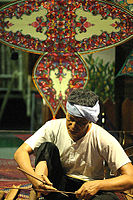 Making a traditional Wau jala budi kite in Malaysia. The bamboo frame is covered with plain paper and then decorated with multiple layers of shaped paper and foil.
Making a traditional Wau jala budi kite in Malaysia. The bamboo frame is covered with plain paper and then decorated with multiple layers of shaped paper and foil.
-
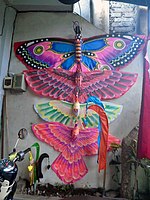 Various Balinese kites is on display in front of a store in Ubud, Bali, Indonesia
Various Balinese kites is on display in front of a store in Ubud, Bali, Indonesia
-
 A kite shop in Lucknow, India
A kite shop in Lucknow, India
-
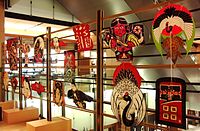 Traditional Japanese kites
Traditional Japanese kites
-
 Different kites are sold at a shop in Hội An, Vietnam
Different kites are sold at a shop in Hội An, Vietnam
Europe

In Greece and Cyprus, flying kites is a tradition for Clean Monday, the first day of Lent. In the British Overseas Territory of Bermuda, traditional Bermuda kites are made and flown at Easter, to symbolise Christ's ascent. In Fuerteventura a kite festival is usually held on the weekend nearest to 8 November lasting for 3 days.
Polynesia
Polynesian traditional kites are sometimes used at ceremonies and variants of traditional kites for amusement. Older pieces are kept in museums. These are treasured by the people of Polynesia.
-
 Māori kite
Māori kite
-
 Launch of ram-air inflated Peter Lynn single-line kite, shaped like an octopus and 90 feet (27 m) long
Launch of ram-air inflated Peter Lynn single-line kite, shaped like an octopus and 90 feet (27 m) long
South America
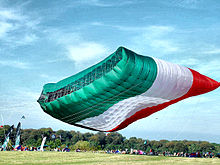
In Brazil, flying a kite is a very popular leisure activity for children, teenagers and even young adults. Mostly these are boys, and it is overwhelmingly kite fighting a game whose goal is to maneuver their own kites to cut the other persons' kites' strings during flight, and followed by kite running where participants race through the streets to take the free-drifting kites. As in other countries with similar traditions, injuries are common and motorcyclists in particular need to take precautions.
In Chile, kites are very popular, especially during Independence Day festivities (September 18). In Peru, kites are also very popular. There are kite festivals in parks and beaches mostly on August.
In Colombia, kites can be seen flown in parks and recreation areas during August which is calles as windy. It is during this month that most people, especially the young ones would fly kites.
In Guyana, kites are flown at Easter, an activity in which all ethnic and religious groups participate. Kites are generally not flown at any other time of year. Kites start appearing in the sky in the weeks leading up to Easter and school children are taken to parks for the activity. It all culminates in a massive airborne celebration on Easter Monday especially in Georgetown, the capital, and other coastal areas. The history of the practice is not entirely clear but given that Easter is a Christian festival, it is said that kite flying is symbolic of the Risen Lord. Moore describes the phenomenon in the 19th century as follows:
A very popular Creole pastime was the flying of kites. Easter Monday, a public holiday, was the great kite-flying day on the sea wall in Georgetown and on open lands in villages. Young and old alike, male and female, appeared to be seized by kite-flying mania. Easter 1885 serves as a good example. "The appearance of the sky all over Georgetown, but especially towards the Sea Wall, was very striking, the air being thick with kites of all shapes and sizes, covered with gaily coloured paper, all riding bravely on the strong wind.
— (His quotation is from a letter to The Creole newspaper of December 29, 1858.)
The exact origins of the practice of kite flying (exclusively) at Easter are unclear. Bridget Brereton and Kevin Yelvington speculate that kite flying was introduced by Chinese indentured immigrants to the then colony of British Guiana in the mid 19th century. The author of an article in the Guyana Chronicle newspaper of May 6, 2007 is more certain:
Kite flying originated as a Chinese tradition to mark the beginning of spring. However, because the plantation owners were suspicious of the planter class (read "plantation workers"), the Chinese claimed that it represented the resurrection of Jesus Christ. It was a clever argument, as at that time, Christians celebrated Easter to the glory of the risen Christ. The Chinese came to Guyana from 1853–1879.
World records

There are many world records involving kites. The world's largest kites are inflatable single-line kites. The world record for the largest kite flown for at least 20 minutes is "The Flag of Kuwait".
The world record for most kites flown simultaneously was achieved in 2011 when 12,350 kites were flown by children on Al-Waha beach in Gaza Strip.
The single-kite altitude record is held by a triangular-box delta kite. On 23 September 2014 a team led by Robert Moore, flew a 129 square feet (12 m) kite to 16,009 feet (4,880 m) above ground level. The record altitude was reached after eight series of attempts over a ten-year period from a remote location in western New South Wales, Australia. The 9.2 feet (3 m) tall and 19.6 feet (6 m) wide Dunton-Taylor delta kite's flight was controlled by a winch system using 40,682 feet (12,400 m) of ultra high strength Dyneema line. The flight took about eight hours from ground and return. The height was measured with on-board GPS telemetry transmitting positional data in real time to a ground-based computer and also back-up GPS data loggers for later analysis.
In popular culture
- The Kite Runner, a 2005 novel by Khaled Hosseini dramatizes the role of kite fighting in pre-war Kabul.
- The Peanuts cartoon character Charlie Brown was often depicted having flown his kite into a tree as a metaphor for life's adversities.
- "Let's Go Fly a Kite" is a song from the Mary Poppins film and musical.
- In the Disney animated film Mulan, kites are flown in the parade.
- In the film Shooter, a kite is used to show the wind direction and wind velocity.
- "Kite" is a 1978 song celebrating kite flying and appears on Kate Bush's first album, The Kick Inside.
General safety issues
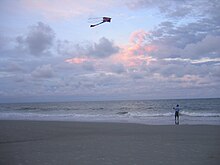
There are safety issues involved in kite-flying. Kite lines can strike and tangle on electrical power lines, causing power blackouts and running the risk of electrocuting the kite flier. Wet kite lines or wire can act as a conductor for static electricity and lightning when the weather is stormy. Kites with large surface area or powerful lift can lift kite fliers off the ground or drag them into other objects. In urban areas there is usually a ceiling on how high a kite can be flown, to prevent the kite and line infringing on the airspace of helicopters and light aircraft. It is also possible for fighter kites to kill people, as happened in India when three spectators were killed in separate incidents during Independence Day, August, 2016—precipitating a ban on certain types of enhanced line.
The government of Egypt banned kite-flying in July 2020, seizing 369 kites in Cairo and 99 in Alexandria, citing both safety and national security concerns.
Designs
- Bermuda kite
- Bowed kite, e.g. Rokkaku
- Cellular or box kite
- Chapi-chapi
- Delta kite
- Foil, parafoil or bow kite
- Leading edge inflatable kite
- Malay kite see also wau bulan (Moon kite)
- Tetrahedral kite
- Sled kite
Gallery
-
This delta kite has a keel instead of a bridle
- Giant Japanese kite launched, 2019
-
Train of connected kites
-
 Kites fly on top of the Mitsui Store where the craftsmen are working on top of the roof, print by Hokusai
Kites fly on top of the Mitsui Store where the craftsmen are working on top of the roof, print by Hokusai
-
 Hiroshige II Enshū Akiha (1859)
Hiroshige II Enshū Akiha (1859)
-
 Illustration from the book Story of the mince pie by Josephine Scribner Gates (1916)
Illustration from the book Story of the mince pie by Josephine Scribner Gates (1916)
Types
- Fighter kite
- Indoor kite
- Inflatable single-line kite
- Kytoon - a hybrid tethered craft comprising both a lighter-than-air balloon as well as a kite lifting surface
- Man-lifting kite
- Rogallo parawing kite
- Stunt (sport) kite
- Water kite
See also
- Airborne wind turbine, concept for a wind generator flown as kite
- Captive helicopter
- Captive plane
- High altitude wind power
- Kite aerial photography
- Kite buggying
- Kite fishing
- Kite ice skating
- Kite landboarding
- Kite shape
- Kiteboating
- Kitelife, an American magazine devoted to kites
- Kitesurfing
- Kite rig
- List of kite festivals
- Sea Tails, video installation
- Solar balloon, a solar-heated hot air balloon that can be flown like a kite, but on windless days.
- Uttarayan, the kite flying festival of western India
- Weifang International Kite Festival
References
- Giant Kite Festival in HigashiomiNHK(video)
- Kytoon
- Eden, Maxwell (2002). The Magnificent Book of Kites: Explorations in Design, Construction, Enjoyment & Flight. New York: Sterling Publishing Company, Inc. p. 18. ISBN 9781402700941.
- "kite | Etymology, origin and meaning of kite by etymonline". Etymonline.com. Retrieved 14 December 2021.
- "Beginner's Guide to Aeronautics". NASA. Archived from the original on 2015-03-25. Retrieved 2012-10-03.
- "Flying High, Down Under". Archived from the original on 1 December 2008. Retrieved 14 December 2021.
- Woglom, Gilbert Totten (1896). Parakites: A treatise on the making and flying of tailless kites for scientific purposes and for recreation. Putnam. OCLC 2273288. OL 6980132M.
- "Science in the Field: Ben Balsley, CIRES Scientist in the Field Gathering atmospheric dynamics data using kites. Kites are anchored to boats on the Amazon River employed to sample levels of certain gases in the air". Archived from the original on 14 March 2008. Retrieved 14 December 2021.
- "The Bachstelze Article describes the Fa-330 Rotary Wing Kite towed by its mooring to the submarine. The kite was a man-lifter modeled after the autogyro principle". Uboat.net. Retrieved 2012-10-03.
- "Kite Fashions: Above, Below, Sideways. Expert kite fliers sometimes tie a flying kite to a tree to have the kite fly for days on end" (PDF). Archived from the original (PDF) on 23 July 2011. Retrieved 14 December 2021.
- "Underwater kiting". 2lo.de. Retrieved 2012-10-03.
- "Hydro kite angling device Jason C. Hubbart". Retrieved 2012-10-03.
- "A tale of prehistoric horses in South Sulawesi", Jakartapost
- Bieck, Wolfgang (July 2002). ""The First Kiteman" -Proof by a prehistoric cave-painting in Indonesia". Archived from the original on 8 September 2017. Retrieved 24 July 2019.
- "Layang-layang Tertua di Dunia Berasal dari Indonesia, Sudah Ada Sejak 4 Ribu Tahn Lalu", Tempo (in Indonesian)
- Salikha, Adelaida (2 June 2018). "The Top 10 Must-Know Facts About The World's First & Oldest Kite". Seasia. Retrieved 24 July 2019.
- Needham (1965), Science and Civilisation in China, p. 576–580
- Sarak, Sim; Yarin, Cheang (2002). Khmer Kites. Cambodia: Ministry of Culture and Fine Arts. ASIN B005VDYAAW.
- Kite Flying for Fun and Science, 1907, The New York Times.
- Tripathi, Piyush Kumar (7 January 2012). "Kite fights to turn skies colourful on Makar Sankranti - Professional flyers to showcase flying skills; food lovers can relish delicacies at snack huts". The Telegraph. Calcutta, India. Archived from the original on August 13, 2013.
- Tarlton, John. "Ancient Maori Kites". Archived from the original on 15 October 2011. Retrieved 19 October 2011.
- Chadwick, Nora K. (July 1931). "The Kite: A Study in Polynesian Tradition". Journal of the Royal Anthropological Institute. 61: 455–491. doi:10.2307/2843932. ISSN 0307-3114. JSTOR 2843932.
- ^ Anon. "Kite History: A Simple History of Kiting". G-Kites. Archived from the original on 29 May 2010. Retrieved 20 June 2010.
- Needham (1965), Science and Civilisation in China, p. 580
- Ley, Willy (December 1962). "Dragons and Hot-Air Balloons". For Your Information. Galaxy Science Fiction. pp. 79–89.
- "Archived copy" (PDF). Archived from the original (PDF) on 2020-06-30. Retrieved 2018-06-12.
{{cite web}}: CS1 maint: archived copy as title (link) - "History of Kites". Archived from the original on 26 April 2012. Retrieved 18 April 2012.
- Military Aircraft, Origins to 1918: An Illustrated History of Their Impact, Justin D. Murphy, page 2
- "China Reconstructs". China Reconstructs. 15 December 1984. Retrieved 15 December 2021 – via Google Books.
- History of Science in Korea, Sang-un Chŏn, page 181
- "Kites- The History Attached With It". Sporteology. 2017-12-03. Retrieved 2019-02-01.
- Taking Flight: Inventing the Aerial Age, from Antiquity Through the First World War, Richard Hallion, pages 9-10
- "신호연신호 개요 (Summary of sending a signal with a kite)" (in Korean). Korea Culture & Contents Agency. Archived from the original on July 8, 2011. Retrieved July 30, 2009.
- M. Robinson. "Kites On The Winds of War". Members.bellatlantic.net. Archived from the original on 2012-01-21. Retrieved 2012-10-03.
- Saul, Trevor (August 2004). "Henry C Sauls Barrage Kite". Soul Search. Archived from the original on 2013-05-23. Retrieved 2012-10-03.
- Grahame, Arthur (May 1945). "Target Kite Imitates Plane's Flight". Popular Science. Retrieved 2012-10-03.
- "World Kite Museum". World Kite Museum. Archived from the original on 2009-04-06. Retrieved 2012-10-03.
- Focke Achgelis Fa 330
- Gazans Fly Firebombs Tied to Kites Into Israel, Sparking Several Blazes, Haaretz, 16 April 2018
- Gazans use kites to set fire to fields, forests in Israel, JNS, 17 April 2018
- Flaming kite from Gaza sets Israeli warehouse ablaze, Times of Israel, 21 April 2018
- Continuing kite threat puts Israeli farmers on edge, YNET, 24 April 2018
- Kite Terrorism: Compensation to Victims Archived 2018-05-02 at the Wayback Machine, Hadashot, 2 May 2018
- Ronalds, B.F. (2016). Sir Francis Ronalds: Father of the Electric Telegraph. London: Imperial College Press. ISBN 978-1-78326-917-4.
- "Could High-Flying Kites Power Your Home?". Smithsonian. Smithsonian Institution. April 12, 2022. Retrieved 2024-11-11.
- Jha, Alok (2008-08-03). "Giant kites to tap power of the high wind". The Observer. Retrieved 2024-11-11.
- "Kitepower Airborne Wind Energy". Retrieved 2024-11-11.
- "Wind Power: Unleashing its Full Potential". Retrieved 2024-11-11.
- "The future of green energy is found high up in the skies". Retrieved 2024-11-11.
- Wales launches £25m underwater kite-turbine scheme The Guardian (retrieved 17 November 2015)
- Underwater Kites Can Harness Ocean Currents to Create Clean Energy Smithsonian.com (retrieved 17 November 2015)
- "Kite Museums – Drachen Foundation". Drachen.org. Archived from the original on 2018-04-30. Retrieved 2018-04-29.
- "Kite.(2007) Encyclopædia Britannica Online". Britannica.com. Retrieved 2013-04-22.
- "Basant: Colorless skies as ban on kite flying in Pakistan continues". www.aa.com.tr. Retrieved 2022-03-14.
- Pogadaev, Victor. Svetly Mesyatz-Zmei Kruzhitsa (My Lord Moon Kite) - "Vostochnaya Kollektsia" (Oriental Collection). M.: Russian State Library. N 4 (38), 2009, 129-134. ISSN 1681-7559
- Sijapati, Alisha (8 October 2020). "Kite fight over Kathmandu". Nepalitimes.com. Retrieved 2020-11-18.
- "Story of a Kite". The New Indian Express. Retrieved 2018-03-15.
- "Weifang World Kite Museum in Weifang,Shandong Province - China.org.cn". China.org.cn. Retrieved 2020-08-25.
- Skeat, Walter William (1965). Malay Magic: An Introduction to the Folklore and Popular Religion of the Malay Peninsula. Psychology Press. p. 485. ISBN 978-0-7146-2026-8.
- 八日市大凧まつり Archived 2015-05-26 at the Wayback MachineNHK(video)
- GIANT KITE FESTIVALS IN JAPAN Archived 2012-03-11 at the Wayback Machine Japanese Kite Collection
- A spectacular festival of some 100 large kites flying over sand dunes. Japan National Tourism Organization
- Hamamatsu Matsuri Archived 2015-05-27 at the Wayback Machine NHK
- "mirantesmt.com". Archived from the original on 2015-08-27.
- Moore, Brian L. (1995). Cultural Power, Resistance, and Pluralism: Colonial Guyana 1838-1900. McGill-Queen's Press - MQUP, ISBN 978-0-7735-1354-9
- Brereton, Bridget; Yelvington, Kevin A. (1999). The Colonial Caribbean in Transition. University Press of Florida, ISBN 978-0-8130-1696-2
- "Welcome to guyanachronicle.com". Archived from the original on 2008-04-16. Retrieved 15 December 2021.
- "Search Results". Guinness World Records. Retrieved 15 December 2021.
- "Largest kite flown". Guinnessworldrecords.com. 15 February 2005.
- "Most Kites Flown Simultaneously". Guinness World Records. Retrieved February 2, 2024.
- "Highest altitude by a single kite". Guinness World Records. 23 September 2014. Retrieved 14 December 2021.
- Moore, R. "Untitled Page". Kitesite.com.au.
- "Egypt grounds kites for 'safety', 'national security'". news.yahoo.com. Retrieved July 12, 2020.
External links
- The earliest depiction of kite flying in European literature in a panorama of Ternate (Moluccas) 1600.
- Mathematics and aeronautical principles of kites.
- Kitecraft and Kite Tournaments (1914)—A free public domain e-book
- Trivedi, Parthsarathi; et al. "Aerodynamics of Kites" (PDF). Archived from the original (PDF) on 12 June 2013. Retrieved 8 February 2013.
- Eyes on Brazil
| Application of wind energy | |
|---|---|
| Wind power | |
| Vehicle propulsion | |
| Kite applications | |
| Air current | |
| Types of aircraft by methods of thrust and lift | |||||||||||||||||||||||||
|---|---|---|---|---|---|---|---|---|---|---|---|---|---|---|---|---|---|---|---|---|---|---|---|---|---|
| |||||||||||||||||||||||||
| |||||||||||||||||||||||||
| Kites and kite flying | ||
|---|---|---|
| Types by use |  | |
| Types by shape | ||
| Activities and applications | ||
| Parts | ||
| People | ||
| Other | ||